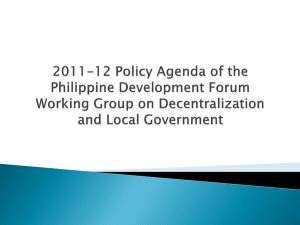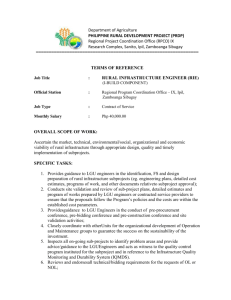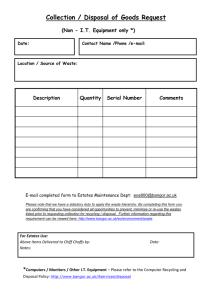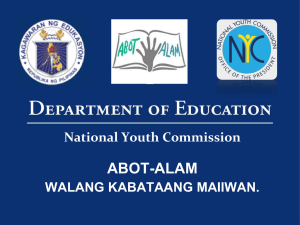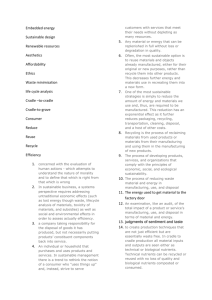TERMS OF REFERENCE
advertisement
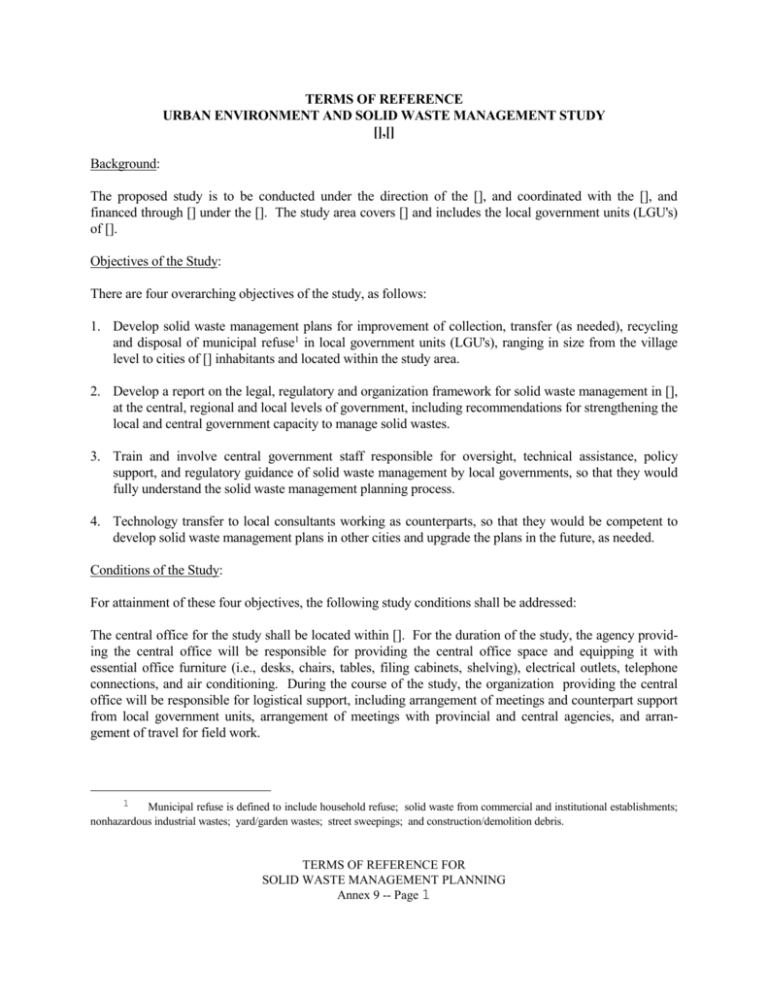
TERMS OF REFERENCE URBAN ENVIRONMENT AND SOLID WASTE MANAGEMENT STUDY [],[] Background: The proposed study is to be conducted under the direction of the [], and coordinated with the [], and financed through [] under the []. The study area covers [] and includes the local government units (LGU's) of []. Objectives of the Study: There are four overarching objectives of the study, as follows: 1. Develop solid waste management plans for improvement of collection, transfer (as needed), recycling and disposal of municipal refuse1 in local government units (LGU's), ranging in size from the village level to cities of [] inhabitants and located within the study area. 2. Develop a report on the legal, regulatory and organization framework for solid waste management in [], at the central, regional and local levels of government, including recommendations for strengthening the local and central government capacity to manage solid wastes. 3. Train and involve central government staff responsible for oversight, technical assistance, policy support, and regulatory guidance of solid waste management by local governments, so that they would fully understand the solid waste management planning process. 4. Technology transfer to local consultants working as counterparts, so that they would be competent to develop solid waste management plans in other cities and upgrade the plans in the future, as needed. Conditions of the Study: For attainment of these four objectives, the following study conditions shall be addressed: The central office for the study shall be located within []. For the duration of the study, the agency providing the central office will be responsible for providing the central office space and equipping it with essential office furniture (i.e., desks, chairs, tables, filing cabinets, shelving), electrical outlets, telephone connections, and air conditioning. During the course of the study, the organization providing the central office will be responsible for logistical support, including arrangement of meetings and counterpart support from local government units, arrangement of meetings with provincial and central agencies, and arrangement of travel for field work. 1 Municipal refuse is defined to include household refuse; solid waste from commercial and institutional establishments; nonhazardous industrial wastes; yard/garden wastes; street sweepings; and construction/demolition debris. TERMS OF REFERENCE FOR SOLID WASTE MANAGEMENT PLANNING Annex 9 -- Page 1 For the duration of the study, the central office shall be permanently equipped through funds provided to the consultants as part of this study with 2 personal computers (486 microprocessor, 8+ MB of RAM, 100+ MB of hard disk storage capacity, able to accept 3.5 inch high density diskettes), 1 printer (dot matrix with near letter quality ability or laser printer, capable of printing landscape and portrait orientation, capable of printing graphics), software (6.0 or above DOS operating system, Windows operating system, Word Perfect 5.1 or above or Microsoft Word 5.0 or above, Lotus 1-2-3 Release 2.3 or above or Microsoft Excel 4.0 or above, Anti-Virus, and PC Tools), energy back-up systems and surge control for computers and printers, 1 desk-top photocopy machine, 1 facsimile machine (with 10+ page memory and capability to function with normal photocopy paper), and essential supplies for the duration of the study (printer ink, diskettes, printer paper, photocopy paper, etc). At the start of the study, the central office shall be provided through funds provided to the consultants as part of this study with reference documents, written in [], which provide an introductory basis for solid waste management planning, including at least 6 major textbooks of high repute, at least 6 guidance documents from agencies such as the U.S.A. Environmental Protection Agency, World Bank, or World Health Organization, and at least 10 substantive articles from journals or conference proceedings. Subjects to be covered by the documents shall include but not be limited to the following: recycling and collection techniques and practices in both industrialized and developing countries; waste characterization study methods; composting and compost marketing techniques; sanitary landfill design and operation; transfer system design and operation; waste treatment and resource recovery technologies; sample solid waste management ordinances for local governments; sample solid waste management laws and regulations for central governments; and sample contract agreements for private sector participation. The foreign solid waste experts shall use the central office as their base, in order to maximize technology transfer and training to counterpart staff. The solid waste expert serving as the Study Manager shall work in the study area for at least 75% of months during the study period. Two of the local consultants participating in the study shall work full time at the central study office while the study is on-going. All other local consultants participating in data collection and analysis, under the guidance of the Study Manager, shall attend regular meetings (e.g., weekly) for purposes of direction and monitoring at the central office, but will work on a day-to-day basis at their local offices and in the field. The [] shall assign at least two staff to work half time with this study for the full duration of the study, under the direction of the solid waste expert serving as Study Manager. Data which is generated in each of the LGU's shall be comparable, i.e., the methods of sampling and analysis used shall lead to comparable data and the evaluation of background conditions shall enable understanding of the similarities and differences among the LGU's. Each of the LGU's solid waste management plans shall be reported in the same format, for ready comparison of data and findings. The process used for data generation and analysis shall be replicable, and simple spreadsheets for data management and analysis shall be developed. TERMS OF REFERENCE FOR SOLID WASTE MANAGEMENT PLANNING Annex 9 -- Page 2 The process used for analysis of alternative collection, transport and disposal systems shall be replicable. Simple spreadsheets for analysis of alternative collection vehicle and collection crew scenarios shall be developed. Simple spreadsheets to determine the appropriate economic breakpoint for transfer systems shall be developed. Costing conducted during the study shall clearly outline all costing factors used in a manner which readily enables comparison of costs and updating, including unit prices of vehicles and containers, staffing for vehicles and facilities, percentage increases for benefits and administrative overhead, consumption rates for consumables and unit prices, interest rates, insurances, duties, economic life, downtime and productivity assumptions. As appropriate, the basis for calculating costs of civil works shall be provided in terms of local costs for time and materials, as well as any foreign exchange requirements. Also, costs for imported equipment shall be provided in terms of international quotations plus factors applied for costs attributable to shipping, portage, registration, duties and sales tax. Scope of Work: The scope of work is designed to address the four objectives for the study, as described above. The scope of work has three key components, namely: 1. Review and assess the existing legal, regulatory, and organization framework for solid waste management within the study areas, including the framework at the local, provincial and central government levels. 2. Develop a solid waste management planning framework for improvement of collection, transport/transfer, recycling, disposal and resource recovery in the various types of LGU's, including rural villages, semi-rural municipalities, and urban municipalities, and for each urban area of over 20,000 inhabitants. 3. Develop solid waste plans based on the most cost-effective and environmentally appropriate technology choices. The tasks under each of these two components are outlined below. The study is anticipated to involve approximately 200 person months of foreign consultants and 450 person months of local consultants over a 14 month period, as well as 24 person months of counterpart staff. Part One of Scope of Work -- Legal, Regulatory, and Organizational Framework: 1. Central Government Laws and Regulations. Review and summarize the central government legal and regulatory framework (or closest proximity thereof) governing solid waste management in the study area, providing precise reference to the legal title of each law, the date of its passage, and the subsequent date and title of any amendments. Include central government laws which govern protection of public health and provide related public health standards for cleanliness; environmental laws which govern environmental protection and provide related discharge standards or ambient environmental standards; central government design standards for road limits on truck weights, design of sanitary landfills, etc.; central government environmental assessment laws which specify which development or project actions require environmental impact assessment reports; central laws which specify public TERMS OF REFERENCE FOR SOLID WASTE MANAGEMENT PLANNING Annex 9 -- Page 3 participation procedures in planning, environmental assessment and project approval; central laws which define hazardous wastes and specify their methods of management; central policies on recycling and resource recovery; central tariff structures and procedures which govern cost recovery for solid waste management; and central laws which define the roles and responsibilities of provincial and local governments in solid waste management. 2. Provincial and Local Additions to Central Laws and Regulations. Review and summarize whether the above central government laws and regulations are augmented at the local and provincial government levels related to the LGU's for which solid waste plans are to be developed under this study. Specifically assess whether the laws and regulations are more precisely and stringently defined at the local and/or provincial levels of government. 3. Local Laws and Regulations. Review and summarize local laws and regulations governing solid waste management within the LGU's. Include local ordinances which stipulate the responsibility of citizens to store, sort, recycle, discharge, and/or dispose of their solid wastes; local ordinances which prohibit littering and clandestine dumping; local ordinances outlining the management of hazardous wastes, including medical wastes; local laws, policies and procedures governing involvement of the private sector in solid waste services; and local laws or agreements which specify the institutional arrangement for solid waste management. If the local laws vary for different regions, based on their historical evolution, describe the differences and whether there are conflicts needing to be addressed at the central level. 4. Sanctions and Enforcement. Review and summarize the sanctions provided under each of the laws and regulations discussed under Tasks 1 to 3. Outline the existing procedures for inspection and enforcement at the central, provincial and local government levels. Discuss the existence and need for Municipal Courts to respond to the common everyday needs of the solid waste sector. Discuss the adequacy of education, vigilance and enforcement within the existing solid waste system. Identify apparent gaps, constraints, and issues. Include consideration of social, cultural, and political constraints to education and enforcement. 5. Organizational Framework. Describe the organizational framework for solid waste management at the central and provincial, as well as at the local levels within each of the LGU's. Outline any short-term task force or committee groups which have a significant role in solid waste management, and discuss the impact of such groups on the permanent solid waste management entities. Provide organizational structures showing the breakdown of departments, divisions, sections, and units, as appropriate, within each solid waste management entity. Show the position of the solid waste management entity within the overall governmental structure at each level. 6. Communication and Coordination. Discuss the process of communication and coordination among entities. For each organizational entity described above, discuss whether its role is advisory, policy setting, operational, regulatory, planning, etc. For each organizational entity discuss issues of authority versus responsibility; status and access for adequate financing; lines of communication upward and downward; access to training and technical assistance; management flexibility in hiring, firing, grading, remuneration, and assignments; accountability for costs and service levels; and autonomy to rationalize service activities. 7. Organizational Staffing. Provide staffing information for each organization entity described above. Show the breakdown in personnel by major category of work (i.e., categories of planning, personnel administration, procurement, accounting, collection supervision, disposal supervision, refuse truck TERMS OF REFERENCE FOR SOLID WASTE MANAGEMENT PLANNING Annex 9 -- Page 4 drivers, refuse collection crew laborers, pushcart workers, sweepers, mechanics, assistant mechanics, disposal site laborers, inspectors). Indicate the average years in service for key personnel categories of work to indicate turn-over and sustainability of training inputs. Analyze the data in terms of span of management (supervisor to crews, mechanics to trucks), and labor intensiveness (total labor in collection work force to LGU population, labor to tonnes of waste handled, crew size per vehicle type). 8. Private Sector Participation. In each of the LGU's, describe any private sector participation which may exist (e.g., refuse collection contractors or franchisees, informal sector recyclers working with collection crews, informal sector pushcart collectors, licensed or informal sector private haulers working by open competition to serve commercial and industrial establishments, private firms under franchise or contractual agreement with the LGU's to mine or reuse resources within waste, tariff collection by concession agreement). Discuss with private investors and commercial banks their willingness and ability to invest within the solid waste sector, and the conditions for investment (i.e., payback period, return on investment, risk management, client acceptability, revenue source acceptability, economies of scale and contiguity). Examine the economies-of-scale which would be required for effectively zoning privatization of solid waste collection services, and propose privatization arrangements (such as franchises, contracts, license agreements) for collection of various waste categories (household, commercial, industrial wastes) which would introduce private sector investment, contestability with government service, and lower costs. 9. Findings, Conclusions and Recommendations. Analyze the above information from Tasks 1 to 8, and summarize findings and conclusions. Describe the issues and needs in improving legal, regulatory, and organization frameworks for solid waste management. Recommend institutional arrangements which would be more supportive of efficient and effective solid waste management. Recommend privatization arrangements which would promote contestability of government service and lead to improved efficiency and reliability of service. Part Two of Scope of Work -- Solid Waste Management Plans in LGU's: 1. Background. Review all existing reports and plans on solid waste management which have been conducted for the LGU's during the past decade. Review land use plans for each of the LGU's, as well as reports dealing with socio-economic conditions and urban infrastructure. 2. Population Distribution. Develop population projections over the next two decades for each of the LGU's. Develop a map of each LGU which delineates zones of low density, medium density, and high density residential development, as well as areas of mixed residential and commercial/industrial development. Indicate areas which are inaccessible by roads traversable by refuse trucks of normal 5 to 7 tonne payload. Indicate roads which would accommodate transfer trucks of 20 to 25 tonne payload and show these major arterial roads on the maps. 3. Waste Character. Waste composition data is useful primarily for determination of whether materials recovery, composting, or waste-to-energy techniques might be economic disposal options. To this end, a limited amount of waste sampling and composition analysis is to be performed in representative LGU's. In the LGU's selected for waste sampling, the samples for composition analysis would be taken from two representative truck loads in three types of neighborhoods: high income, low density residential; low income, high density residential; and central city mixed residential and commercial. The composition (in terms of percentage by wet weight) shall be reported in terms of the following TERMS OF REFERENCE FOR SOLID WASTE MANAGEMENT PLANNING Annex 9 -- Page 5 components: vegetable/putrescible matter, paper, cardboard, plastic film, durable plastic, ferrous metal, other metal, glass, ceramics, bone, rubber, textile, yard waste and miscellaneous fines. Workers conducting the composition studies shall be equipped with protective clothing, puncture-proof gloves, and dust masks. Representative samples are also to be taken for laboratory analysis of moisture content (percent weight loss after oven drying) and lower calorific value (i.e., wet, as received, in kcal/kg). 4. Waste Quantity. Conduct field reconnaissance surveys in each LGU, within representative neighborhoods of low-income, medium-income, and high-income residents, as well as in neighborhoods of mixed residential and commercial development. Observe and make field notes as to the size of containers and quantity of wastes being discharged from each type of residential and commercial establishment within each type of neighborhood. Take photos for documentation and office analysis. From representative neighborhoods, conduct a program of weighing truck loads. This involves weighing trucks full and empty, to get the exact load weight, on days of peak and non-peak waste generation (i.e., Monday and Tuesday may be peak waste generation days after weekend activities) and during seasons of peak and non-peak waste generation (i.e., peak waste generation may occur after the rainy season when fruits and vegetables are plentiful and yard waste generation is high). If the study's time frame does not allow weighing during peak and non-peak seasons, records from each urban LGU of waste loads discharged at the disposal sites shall be evaluated to estimate the potential peak day variance and seasonal variance. If records of reliable quality to do not exist, an exercise to count trucks and estimate volumes arriving at official disposal sites shall be conducted over a 10 day period. 5. Waste Density. Waste density measurements provide the means for determining the economic viability of employing compaction mechanisms on refuse collection trucks. To this end, conduct a program of weighing refuse containers, open refuse trucks, and compaction refuse trucks. Weigh representative household containers, communal containers, loads in open trucks (i.e., open tipper, closed side loading tipper), and loads in compaction trucks (i.e., lateral compactor, rear loading compactor, and rotary screw compactor). Estimate the percentage to which each container is full, measure its actual volume to contain waste, and calculate the density of the waste. This weighing program shall be done in representative high-income, medium-income, low-income, and mixed commercial/residential neighborhoods within representative LGU's. 6. Projected Waste Quantity and Character. Obtain information on existing and projected gross regional domestic product for each of the LGU's covered in this plan. Based on projected population and economic growth estimates for each of the LGU's, project how waste generation and character would be likely to change over time. Include in the projection a scenario for recycling levels to be maintained at current levels and a scenario based on achievement of optimum recycling levels by the end of two decades. Consider that future municipal waste generation is not likely to exceed the plateau of about 1 kg/capita/day (exclusive of major industrial sources and construction/demolition debris) currently observed in Japan, Hong Kong, and Singapore. 7. Public Participation. Survey residents in representative neighborhoods of each of the LGU's regarding their patterns of behavior in waste storage and discharge, as well as their preferences and concerns. Discuss issues such as: where do they store their waste prior to collection, how long could they store their waste on-site, do adults or children have responsibility to put the waste out for collection, do they invest in permanent waste receptacles with covers, can they leave such receptacles on the curbside without concern about theft, would they be willing to walk to a communal receptacle for waste collection, do they believe they are conscientious about keeping their neighborhood clean, do they believe their neighbors are conscientious about keeping their neighborhood clean, do they believe that TERMS OF REFERENCE FOR SOLID WASTE MANAGEMENT PLANNING Annex 9 -- Page 6 public education is needed, do they believe that more vigilance and enforcement of existing laws are needed, and what type of solid waste service would they prefer. Further discuss with residents their willingness to pay for solid waste collection service of different types (door-to-door, communal container, scheduled block) and how much they could afford relative to their available household income. For purposes of compatibility and comparability of this information, one team shall be used to conduct the surveys in each of the urban LGU's in sequence. 8. Equipment Inventory. Examine collection and disposal equipment in each of the LGU's covered in the plan. Make a complete list all refuse collection vehicles and landfill equipment units owned by manufacturer, type, volume, and purchase date. For each item of vehicle and equipment, designate whether it is one of the following: owned and regularly operable; owned and not operable, but refurbishable; units which should be sold as scrap. For each item which is regularly operable, estimate the downtime which it is experiencing and its remaining economic life. For each item which is owned and not operable, designate whether it economically could be refurbished, whether it is useful only for spares or whether it should be scrapped. This data typically is readily available from the workshop supervisor based on his/her best professional judgment. While the list can initially be developed by junior staff, an experienced engineer on the consultant's team shall visit the workshop in each LGU to verify the results. 9. Facility Inventory. Examine and describe all facilities for equipment repair/maintenance and waste disposal. Make an inventory of tools, supplies, and facilities available at each site. Estimate the size of each site (i.e., in hectares) and list the basic infrastructure available (i.e., sanitation facilities, water supply, electricity, drainage, sewerage). Describe the age of the facility and, in the case of disposal facilities, estimate the remaining life. Provide a professional opinion of the appropriateness, physical condition, accessibility, capacity, and environmental acceptability of each facility. 10. Collection Service Level Assessment. Perform time and motion analysis of representative refuse collection vehicles and crews, from high-income, low-income, and mixed commercial/residential neighborhoods in representative LGU's. Include time and motion data for the following: check in time; start up time; travel time to first route; overall collection time on the route; stop-to-stop times; loading times; time spent on recycling, breaks, and collection of tips; travel time to disposal site; time spent on selling recyclables; queuing time at disposal site; disposal unloading time; travel time to second route, etc. Compare the time and motion data obtained with information obtained from field supervisors and solid waste managers regarding typical vehicle and crew productivities. Compare the time and motion data obtained with information obtained from checking records of delivered loads at the disposal sites. Assess the disposal site records to determine the variance in time and motion between the wet and dry seasons. Based on the above time and motion data and the data obtained on truck load weights, determine the typical vehicle and worker productivities (i.e., tonnes/day per vehicle and per worker) currently being achieved in wet and dry seasons for each type of vehicle and each type of neighborhood existing in the representative LGU's. Further determine, based on the available operable fleet and the estimated quantity of waste being generated in each LGU, the percentage of the waste being collected during the wet and dry seasons. 11. Collection Costing Analysis. For alternative collection techniques (including but not limited to open tippers, skip container hoist trucks, arm roll container trucks, side loading tipper trucks, and rear loading compaction trucks) analyze total owning, operating and maintenance costs and costs/tonne. Use a computerized spread sheet for this analysis and train the local consultants and counterpart staff on its use. Based on the appropriateness of each collection technique for conditions of access and community TERMS OF REFERENCE FOR SOLID WASTE MANAGEMENT PLANNING Annex 9 -- Page 7 behavior in various types of neighborhoods, recommend which collection technique would provide the most cost-effective collection service for each type of neighborhood. Consider issues of skill levels required for operation and maintenance, availability of spare parts, flexibility of application, fuel consumption, and ease of loading in considering which collection techniques would be most costeffective. Based on the existing fleet and the overall needs as determined through this costing exercise, determine the number and types of collection vehicles needed in each LGU. Further develop a schedule of replacement and extension for yearly purchases over the next two decades. 12. Recycling Systems. In each LGU, survey licensed and unlicensed agents purchasing secondary materials (i.e., recyclables such as paper, plastic, textile, metal, and glass waste materials). Determine how much waste is being recovered for recycling back to industry. Determine the sources providing recyclables to the agents, including refuse collection crews, itinerant waste pickers buying from residents, and waste pickers working at the disposal sites. Meet with representative industrial users for recyclables. Discuss their buying specifications and their buying network of agents. Determine whether the market demand exists or could be readily developed for increasing the level of recycling. Discuss what incentives might enhance recycling and increase demand. Recommend initiatives which could be implemented as pilot projects to enhance recycling. 13. Transfer and Disposal Systems. Examine which of the existing disposal sites are in environmentally acceptable locations (e.g., with respect to groundwater and surface water conditions) and whether these sites are amenable to continued use or expansion. Also examine the sites where new disposal facilities have already been proposed and significant progress has already been made toward design and/or development. For LGU's where new disposal sites are needed, reconnaissance the LGU's and surrounding environs for potentially suitable sites with adequate capacity and daily soil cover available to provide sanitary landfill for 20 years. Compare the existing, proposed, and potential disposal sites for their strategic location compared to waste generation areas, accessibility by major arterial roads, availability of daily soil cover, cost of land acquisition, cost of human settlement, cost of site preparation, and environmental acceptability. Based on economic travel times and distances for direct haul by collection vehicles (e.g., no more than 30 minutes travel time one way for collection vehicles carrying under 5 tonnes/load, and no more than 45 minutes travel time one way for collection vehicles carrying 5 to 8 tonnes) and, if appropriate, economic breakpoints for optimum utilization of equipment (e.g., no less than 300 tonnes/day per landfill bulldozer or less than 120 tonnes/day per transfer station), determine the number of sanitary landfills and, if appropriate, transfer stations would be most costeffective for each of the urban LGU's. Provide a strategic plan which shows the recommended areas where sanitary landfills and transfer stations would ideally be located. 14. Resource Recovery Systems. Sanitary landfill is required in any LGU as a means of safe disposal of untreated solid waste or resource recovery residuals (i.e., composting rejects, construction/demolition debris, ash), even if all or a portion of the solid waste stream is subjected to resource recovery processing. Based on the composition and character of the solid wastes within each of the LGU's, determine whether composting or waste-to-energy systems of resource recovery are technically viable. Incineration and waste-to- energy are highly unlikely to be technically viable in developing countries, because the waste composition is not high enough in combustibles (paper, plastic, textile, bone) to have a calorific value enabling self-sustaining combustion. The minimum level for self sustaining combustion is 1300 kcal/kg lower heating value and most developing countries have levels below 1100 kcal/kg. If composting or waste-to-energy are technically viable, determine whether the existing or probable market for the recovered resources (i.e., compost, steam, and heat), would be willing and able TERMS OF REFERENCE FOR SOLID WASTE MANAGEMENT PLANNING Annex 9 -- Page 8 to cover the cost difference between resource recovery and sanitary landfill of the total solid waste stream. For waste-to-energy, this would typically mean a grid buying price from small generators of at least 0.08 $US/kwh. For compost, this would typically mean that animal manure sells for a price which is comparable to what it would cost to produce compost and farmers have enough revenues/hectare to support purchase of at least 3 tonnes/hectare at this price. Provide a strategic plan which shows the size and location of recommended resource recovery facilities. 15. Existing Budgets and Financial Resources. Provide a review of the existing budget for all local government activities within each LGU. Provide a breakdown of the sources of revenues collected locally through taxes, penalties, license fees, etc., as well as revenues provided through subventions from state and central government. Outline the existing budget for solid waste management, include a breakdown of costs for regular salaries, overtime salaries, personnel benefits, administrative overhead, supplies, spare parts for vehicles, consumables for vehicles, contracts, vehicle and equipment purchase, debt service, insurance, registration, civil works of collection points, etc. Discuss whether any user charges, tipping fees, license fees, or sanctions exist within the solid waste management system. If there are private contractors, franchisees or individuals with carts conducting refuse collection within any neighborhoods, outline their tariff structure. Conduct a demand assessment and willingness to pay survey in neighborhoods of various incomes within representative LGU's. The survey shall query households, commercial establishments, and industries for the amount they would be willing to pay for each of the range of technologies for collection and recycling which might be viable to serve them (i.e., communal collection containers - short distance, communal collection - long distance, door-to-door curbside service, backyard collection, separate collection of recyclables, collection where bins or backs are provided by the collector). They shall also be questioned regarding the method of collection they prefer and which problems they consider most significant with regard to collection services. For each household, commercial establishment, and industrial category, determine their ability to pay as a function of their gross and net revenues, as well as basic expenditures. Based on the above, develop recommendations for how to recover costs for collection, recycling, transfer, disposal, and resource recovery activities -- either through one cost recovery mechanism for all of the activities or through separate ones for each activity. Develop a tariff structure for each cost recovery mechanism, allowing for charges to be based on costs as well as willingness and ability to pay of each type of waste generator. Take into consideration the need for equitable cross-subsidies. Provide recommendations on the phased implementation of the tariff structure for each cost recovery mechanism. 16. Findings, Conclusions and Recommendations. Analyze the above information from Tasks 1 to 15, and summarize findings and conclusions. Recommend plans for improvement of collection, recycling, transport, and disposal, include cost analysis of alternatives which were considered as part of the study. The plans and costs should be adequate to support pre-appraisal of a World Bank project, i.e., at the level of preliminary engineering design for budgetary costing purposes. The plans and costs should take into consideration utilization of potential sites for facilities which are likely to be available, even though it is anticipated that these solid waste management plans would be followed by siting studies. Provide an analysis for how the implementation of the recommended plans would affect recurrent expenditures, including debt service and fleet renewal over the first 10 years following implementation. Reports: The consultants are expected to produce the following reports during the course of the study: TERMS OF REFERENCE FOR SOLID WASTE MANAGEMENT PLANNING Annex 9 -- Page 9 1. Inception Report: Within two months, the consultants shall produce an inception report outlining initial observations, apparent availability of data, and detailed work program for the two components of the study. The work program shall describe the survey, sampling, and laboratory analytical protocols to be used in data collection. The work program shall include a detailed schedule for all work, including field work in each of the urban LGU's. The inception report shall also report on the fulfillment of the study conditions, as outlined above. 2. First Interim Report: Within six months, the consultants shall produce an interim report outlining (i) background information and data generated in each of the urban LGU's, as well as the range of LGU's grouped in categories (rural, semi-rural, etc.,); (ii) issues and needs in each of the urban LGU's, and the range of LGU's grouped in categories; (iii) collection, transport, recycling, and disposal alternatives which appear to be appropriate for analysis; and (iv) findings from the legal, regulatory, and organization review. 3. Second Interim Report: Within ten months, the consultants shall produce a second interim report outlining (i) analysis of collection, transport, recycling, and disposal alternatives; and (ii) analysis of legal, regulatory, and organization findings. 4. Final Draft Report: Within 12 months, the consultants shall produce a draft final report including (i) final presentation of all background information, data, and findings; (ii) analysis of issues and needs; (iii) plans to improve solid waste collection, transport, recycling, and disposal in each of the urban LGU's, as well as the range of LGU's grouped in categories; (iv) recommendations to improve the legal, regulatory, and organization framework for solid waste management at the central, regional and local government levels; and (v) recommended actions for potential investment programs. 5. Final Report: Within 1 month from receipt of comments from agency reviewers, the consultants shall produce a final report addressing review comments. Staffing Requirements: The study manager shall be a foreign specialist with a minimum of a bachelor’s degree in civil engineering, with at least 20 years of work experience and at least twelve years of experience in solid waste management planning activities. The study manager shall have participated in solid waste management planning studies conducted in at least three developing countries, outside of his/her home country. The study manager shall have experience in the development of project plans and budgetary estimates, including foreign and local exchange costs, for purposes of World Bank or comparable multilateral financing. The study team shall include one foreign specialist with a minimum of a bachelor’s degree in mechanical engineering, and at least twelve years of experience in the specification, operation, and maintenance of mobile equipment such as trucks and earth-moving equipment. The specialist shall have experience which is relevant to assessing the needs and capabilities of a local government to operate, maintain and repair a fleet of refuse collection and disposal equipment. The specialist shall have worked on mobile equipment requirements in at least two developing countries, outside of his/her home country. The study team shall include one foreign specialist with a minimum of a bachelor’s degree in civil engineering, and at least ten years of experience in sanitary landfill design. The specialist shall have TERMS OF REFERENCE FOR SOLID WASTE MANAGEMENT PLANNING Annex 9 -- Page 10 experience in the development of sanitary landfill siting and design requirements in at least two developing countries, outside of his/her home country. The study team shall include one local specialist with training and experience in solid waste management planning, and at least 8 years of experience of working of environmental and waste management issues within the study area. The study team shall include one local specialist with a master’s degree or equivalent in either public administration, organizational management, or law, and at least ten years of experience in activities of direct relevance to the scope of work required under the legal, regulatory, and organizational framework portion of the study. While experience in analysis and development of institutional arrangements for local and/or central government agencies is essential, experience with agencies directly responsible for solid waste management is not required. The study team shall include one local specialist with a minimum of a bachelor’s degree in economics or finance, and at least eight years of experience in review and analysis of budget, expenditure and revenue data bases of government agencies. The specialist shall also have training, and preferably experience, in the development of financial arrangements for cost recovery. The study team shall include one local specialist with a minimum of a bachelor’s degree in civil engineering, and at least ten years of experience in earthworks and road design, building design, and construction within the study area. The specialist shall have the capability of developing budgetary cost estimates of civil works for purposes of project appraisal, including estimation of local and foreign cost components. TERMS OF REFERENCE FOR SOLID WASTE MANAGEMENT PLANNING Annex 9 -- Page 11

